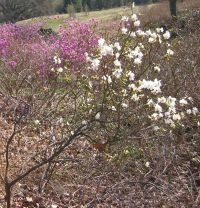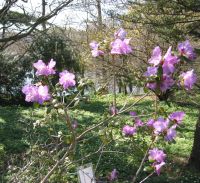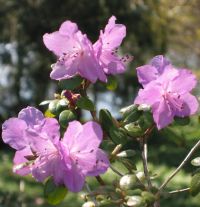Dahurian rhododendron - Rhododendron dauricum
English name:
Dahurian rhododendron
Scientific name:
Rhododendron dauricum
Family:
Ericaceae (heath family)
Height:
to 2 M in Hørsholm
Flowering:
March & April, individual flowers will also open in the autumn
Range:
Russia from Altai to Kamchatka, N. China, Korea, & Hokkaido
 |
|
 |
 |
The Rhododendron dauricum plants in the pictures are from various plants in our collection. They can be found in for example square 1904 positions 3116 to 3317 on the north side of the rhododendron valley by the road bordering our nursery. A map with squares and positions can be found on our homepage under: Plant search.
Plant description:
It has been a cold March and thus many plants will be flowering and breaking bud late this year. Late springs are not entirely bad. The late spring this year has given extra time to check the identity of some plants. This months plant, Rhododendron dauricum typically has semi-evergreen leaves. That is most leaves fall off leaving only a few leaves on the tips of the twigs. In contrast the closely related Rhododendron mucronulatum has fully deciduous leaves. All the plants we have labelled as R. dauricum showed the expected semi-deciduous leaves when checked. Most of our plants labelled as Rhododendron mucronulatum were fully deciduous when checked. But those that we have from Vladivostok were not fully deciduous, indicating that something is wrong. Most likely these plants are hybrids, as the two species interbreed in the wild. They however turn out to be R. dauricum.
We have 13 examples of Rhododendron dauricum. Our oldest living plants came from the Moscow University Botanic Garden and in 1968. We also have two provenances from the Nordic Arboretum Committees expedition to Japan in 1976. Both provenances are from the northern Island of Hokkaido. Additionally we have one specimen with white flowers, which was a gift from Johannes Hedegaard. Rhododendron dauricum was first described more than 250 years ago by Karl von Linne (Linnaeus). It was grown in the Copenhagen Botanic Garden as early as1852. White-flowered forms were probably initially discovered at an early date by Japanese plant collectors. A white form was introduced into Europe as early as 1839.
These are upright, semi-deciduous shrubs, with a rather open branching pattern. The leaves are dark green on top and pale green beneath. They turn reddish-brown in the winter except in the white flowering form that we have. Its leaves remain a pale green over winter. The leaves are leathery in comparison with R. mucronulatum. The scales on their leaves and twigs (can be seen with a good magnifying lens), reveal that they belong to the subgenus Rhododendron (lepidotes). In comparison to their nearest relative, R. mucronulatum, the leaves and flowers are typically smaller. However, there is considerable variation in these characters within these two species, and they hybridize to form swarms of intermediate types in nature. The widely, funnel-shaped, flowers are typically rosy-purple in colour. They open successively in each flower head.
R. dauricum grows over a wide area in northeast Asia and is a component of variety of different plant communities. One would therefore expect there to be many different climate races (provenances) and the timing of flowering and other features to vary considerably.
An important feature of R. dauricum is the frost hardiness (down to -30 °C, perhaps even lower) which makes it a suitable species for much of Scandinavia. Another important feature is the very early flowering in many provenances. There are also a number of named cultivars. In addition this species is often used to create hybrids with other species that are especially early flowering. All in al this is a fine species for the early spring when we are all in need some brighter colours. The leaves are pleasantly scented and the plants are reported to be resistant to deer browsing.
References:
Bean, W.J. 1976 Trees and Shrubs Hardy in the British Isles Vol III. N-Rh. Bean and Murray publishers. 973 pp.
Cox, P.A. & Cox, K.N.E. 1997. The Encyclopedia of Rhododendron species. Glendoic Publishing, Perth Scotland. 396 pp.
Davidian, H.H. 1982. The Rhododendron Species Vol I. Lepidotes. B.T. Batsford Ltd. London 431 pp.
Lange, J. 1999. Kulturplanternes Indførselshistorie i Danmark indtil midten af 1900-talet. (Introduction History of Cultivated Plants in Denmark up to the middle of the 20th century). DSR Forlag, Frederiksberg C. 458 pp.
Elizabeth Carlhian, Concord, MA: http://www.rosebay.org/chapterweb/specdaur.htm
